Three Days of Volvos
Phil Singher
editor@vclassics.com
We got to the Volvo at the Glen event towards the end of a too long, too busy trip that followed on the heels of a too long period of too much work and too many other activities. By the time we arrived, I was both exhausted and sick with what turned out to be a nasty respiratory infection. Those three days were a blur as they happened. Perhaps they're sharper as memories.
The Place
The racetrack sits on and around a wooded hilltop way out in the countryside of western New York State. It's right at the southern tip of Lake Seneca, one of the famed Finger Lakes, and not close to anything much except the small towns of Montour Falls and Watkins Glen itself. It's a beautiful place.
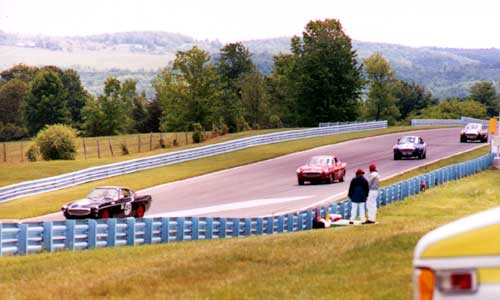
The course is nearly three-and-a-half miles long with every sort of turn, straights of various lengths and a fair amount of elevation change. You can check it out by visiting www.theglen.com. On a low-key vintage racing weekend, spectators can roam around and view the racing from many points around the course, including from a large grandstand. There are many areas set aside for trackside camping and most of the paddocks are open to all. The icing on this particular cake was that Mark Hershoren had taken it upon himself to procure press passes for the whole VClassics crew, which got us into a few other areas in which the really exotic machines were protected -- from what, I'm not sure, but they were.
One could not ask for a nicer, friendlier setting for vintage racing, even in the drizzle and occasional thunderstorms that punctuated the weekend. It's just about ideal.
Coordination
Kudos to Volvo Sports America for having the inspiration of holding the event is such a historic and benign setting. They pulled it off and they made it happen, and I'm sure it wasn't easy. That's the good part.
Now the not-so-good part. From the standpoint of many racers, there was a deplorable lack of coordination that resulted in some not being able to, or choosing not to attend. There is no prize money in vintage racing -- it's done as a hobby. Racers race when they can fit it into schedules full of the sort of family and business committments we all face, and when they can afford to. Entry fees are hundreds of dollars and many are on tight racing budgets.
The previous Volvo Gran Prixes (at Blackhawk Farms in '96 and Road America in '98) were primarily organized by Ray Freiwald, a long-time racer and official of the Vintage Sports Car Drivers Association who knows what's what. Ray arranged for licenses from any of the regional associations to be accepted by the hosting association at both those events (insurance and liability issues are involved) -- a racer could come from the West Coast, present his or her license, pay a single entry fee, and participate in whatever group races his or her car fit into for all three days, not only in a single all-Volvo feature race. For racers coming from more than a few hundred miles away, sponsorship was arranged to compensate them for transportation expenses, at least in part. And perhaps most significantly, all this was in place well over a year before those events, so racers could plan, budget, sign up and prepare accordingly.
This year, racers got their first official notice six weeks before the event, and the news was not great. The entry fee was good only for the single all-Volvo race and the all-Volvo practice sessions. A racer wanting to compete in the regular group races or the enduro had to first join the hosting club (HSR) and be licensed by them, and then pay the full entry fee for those races plus the separate fee for the Volvo feature. No mention was made of any "tow money" for transportation.
At VGP I and II, a racer paid around $500 for a full weekend of racing against other marques as well as participating in the all-Volvo race. Everything was known to all a year or more in advance, so there was plenty of time to make all necessary arrangements. At this year's event, any racer except for the few that happened to be HSR members faced a $2000 bill for the same amount of time on the track (including an HSR membership most would probably never use again), had six weeks to make arrangements (some had already signed up for local races or had other committments that couldn't be changed on short notice), and expected to pay all transportation expenses out of pocket (in fact, some compensation was available, but few, if any, knew it in advance).
18 Volvos showed up, which is a respectable number, but well short of the expected 40 cars.
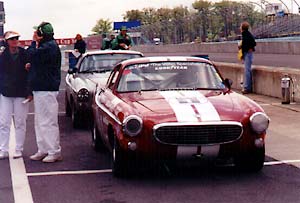 Racers and Race Cars Racers and Race Cars
All the cars entered were OHV-engined Volvos -- 544, 122, 1800 and 140 series -- and one might expect that they'd be prepared in roughly similar ways. That wasn't the case at all, due to both their owners' inclinations and the widely differing rules the cars normally race under in their respective regional associations. There is no national consensus on what constitutes a vintage Volvo race car, and there were several ITB cars in the mix (which are not technically "vintage" by anyone's definition).
To illustrate this, let's compare three 1962 P1800s, presumably nearly identical when they left the Jensen factory 39 years ago. Duane Matejka races mostly in the Volvo Historic Series and in HSR, where substantial modifications are permitted. He's been champion of the VHS four years running, races as often as possible, and has a certain amount of financial help from the numerous sponsors whose names appear all over the car. Anything Duane can figure out to make the car go better while remaining legal, he's got the incentive to do. The result is what's probably the most highly-developed vintage Volvo on the continent -- an extremely impressive machine and a commendable achievement.
Rick Hayden has taken a completely different approach. He's got "custody" (Rick's term) of both cars Art Riley campaigned in the early '60s, and he's restored them to that point in time. He's gone through enormous lengths to make the better of the two -- the red car -- exactly the way it was when Art raced it at Sebring in 1964, right down to the tires. He races it as a tribute to Art's considerable success and only at events which themselves have sufficient historical significance to warrant it. He taps out his full budget (and then some) to do that much, which is a lot, in my opinion. It's not taking anything away from either Rick or Art to point out that a car prepared to 1964 standards is not nearly as fast as a car prepared to 2001 standards. It's great to see Duane and Rick on the same track at the same time, but it can't be called "competition."
Gary Jebsen has a very sanitary example of what I'll call (forgive me, Gary) a "normal" vintage racer. It's lightened everywhere he can lighten it, it's got a very well-done motor with big Weber carbs on it (legal in some associations and not in others) and every bit of the car has been gone through, but there's nothing at all exotic about it. This is a car many could build if they had the dedication and resources to do so. He races it when he feels like it because racing is fun, and he does very well with it. "I really don't care about the old Volvo thing," he told me. "I just happen to race one."
There was more than enough achievement in the paddocks to go around. Tony Martins towed his F-production 1800S all the way from Colorado and also entered the enduro -- the only racer to do so. Bill and Tricia Rose came with another F-production car from Florida -- the only 1800ES racer I'm aware of. John Hamilton ran the only PV in the race -- it has a B18 motor because he likes B18s, even though the rules would permit the larger B20, and it goes plenty fast. Patty Enzman-Alspach -- the only woman entered -- was truly impressive in her 122S (more sheer talent than unusually fast car, I'd venture). IPD founder Richard Gordon returning to racing in a borrowed car, Dave Rauch, Ken Rodenbush... well, I can't mention everyone. You guys that were out there know who you are and you know what you do.
And then there's John Parker. If I ever get the chance to go vintage racing myself, I'd want to do it like this guy. For years he's usually raced only when it could be a family camping outing, and he'll regularly pass up races to coach the local kids' soccer team. He tows the car on an open trailer behind a delapidated van he bought for a few hundred bucks. The car's sort of a beater too ("I painted it silver so the duct tape wouldn't show so much") and he spent the first few practice laps getting rust off the brakes while last fall's dead leaves blew out of the cockpit. There was a hole in the dash where a tach should be. The motor was distinctly tired -- in fact, it shredded the thrust bearing and parts of its crank before the weekend was over -- but he'd gotten buried in other projects and the new motor he'd hoped to have for this event hadn't even begun to materialize. And he still went like stink.
I'm perverse enough to love that.
Seneca Lodge
Marsha and I had actually registered for the VSA meet. This was $175 for the two of us, but once you figure in the cost of a few good meals, a weekend pass to the track and the discount on hotel rates, these things are usually pretty good deals. This time, however, the nearest hotel that could accommodate that many people was 20-some miles away in Corning, so when it became apparent that everything having to do with the meet would actually be at the track, we began looking for lodging closer to it. There wasn't any we could find.
Duane Matejka saved the day. He'd mentioned months earlier that he planned to book a block of rooms at someplace near the track and that our VClassics group might want a few of these, but I'd heard no more about it and figured Duane had had plenty else to do. A few days before we began our trip, I asked (grasping at straws) if he had any leads on a place for us, that I learned we'd been set all along. Excellent!
Duane described the Seneca Lodge as somewhat rustic ("No phones in the rooms") and was concerned that we might not find it suitable. No worries! In fact, it's a lovely place, perfectly comfortable, has a terrific (and historic) bar, is maybe one mile from the track, and also happens to be HSR headquarters. We're used to camping for weeks at a time in a VW Westfalia, so this was more than deluxe. And what would we want with a phone in the room, anyway?
The rest of our contingent -- Mark Hershoren, Deb Donovan, Brooks Townes, Lee Holman and Michael Schultz -- had gotten in on another deal entirely. If ordered by a certain date, $40 got you not only a weekend pass to the track, but also three days of trackside camping.
Friday evening, while VSA held its reception in the hotel in Corning, we were all having a great time at the Seneca Lodge's restaurant. After two drinks and a truly fine meal (all of which Michael insisted on paying for), it was only the demonic cough from my stupid respiratory crud that was keeping me from nodding off at the table.
While I've corresponded with Duane for years, I'd never actually met the man. He'd towed his car off for some last-minute repairs that couldn't be done on the spot and hadn't been at the track all day. Suddenly, there he was, standing by our table. I have no idea if I said anything remotely coherent to him or not, but it was supposed to be along the lines of, "I'm really happy to meet you at last, and thanks so much for getting us rooms in this wonderful place." Duane, whatever I mumbled, that's what I meant. Really.
Concours
Many of you already know that I don't get too excited about the concours thing. If I spot an old Volvo while I'm out running errands, I'll walk across a large parking lot to check it out. When I see 60 old Volvos all parked together, I'm not particularly intrigued. I don't know why this is, but it's so. I already said I'm perverse.
On this day, there were perhaps 200 old Volvos all parked together. This was far and away the biggest meet I've ever seen -- maybe the biggest Volvo meet that ever was, for all I know, and every car there looking nicer than either of ours ever has since we've owned them. Out of a no doubt misguided sense of duty, I meandered through the rows of them for maybe 20 minutes. Everything's relative, though, and two cars stood out from all that gleaming paint and chrome -- one 122S and one 1800S were absolutely stunning. I don't know who owns them and I don't know if they won (look, I'm an editor, not a reporter), but there's no justice if they didn't.
So much for the concours.
More of Saturday
Marsha and Deb had gone exploring in Montour Falls and the others had all gone off wherever it was they went, so I pretty much strolled around for a few hours looking at whatever got in front of my eyes. After while, that happened to be Marsha, who was looking for me. Time for lunch.
Now we had a decision to make. We could either eat for free in the Press Hospitality place, or we could eat for free on VSA because we'd signed up for the meet. After some discussion, we went looking for the press meal -- but even with a good map of the grounds, we just couldn't find it. That is, we found a smallish tent right where Press Hospitality was supposed to be, but there was no one in it, much less any food. Oh well.
Back we went to the VSA tent behind the grandstands. No food there, either; we were too late. It had apparently been that fabled meal known as "box lunch," but they were all gone. I didn't regret this quite as much as not finding the press food. We may have bought something at a concession stand or we may just have given up on lunch entirely; I don't remember anymore.
At some point, I met up with Mark and we toured the various Volvo racer paddocks, chatting with people we knew and meeting people we didn't. As everyone got busy preparing for the afternoon practice, we cruised out to the furthest end of the track (known as "The Boot") and found ourselves some good photo-taking spots. As the cars came by, I snapped up a whole roll of film in the first five laps. No sooner had the camera gone into rewind mode than Richard Gordon spun completely around right in front of me. He was back racing again long before I got new film loaded, of course. I like Richard just fine, but I was sure Cameron would enjoy a pic of his ultimate boss doing something embarrassing. One can't have everything.
Mark had been on his cell phone on and off all day talking to Fraser Earle, who was somewhere else entirely but drawing steadily closer. For those of you who can't place the name, Fraser is the guy who, together with a few teenage friends, built a 544-based, fiberglass-bodied sports racer some 40 years ago and called it 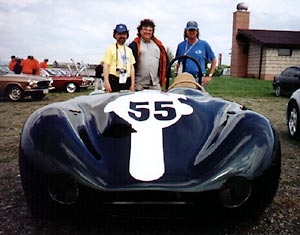 The Davy Special. He'd somehow discovered the remains of the car in a barn about two years ago, had bought it back and was restoring it. Now he was bringing it from Canada to The Glen for its first public outing -- it was not quite running yet and couldn't be raced, but it could be shown and we were eager to see it. The Davy Special. He'd somehow discovered the remains of the car in a barn about two years ago, had bought it back and was restoring it. Now he was bringing it from Canada to The Glen for its first public outing -- it was not quite running yet and couldn't be raced, but it could be shown and we were eager to see it.
We had no idea what Fraser looks like these days, but he found us. He's a big, cheerful guy who looks 20 years younger than the age he must actually be. The car arrived around mid-afternoon, and it's just plain gorgeous. Mark, Lee, Deb and I all took turns sitting in it and making motor noises before a crowd gathered, which didn't take long. (It was the car that drew them -- our noises couldn't have been heard over the howl of cars on the track.)
The Davy Special has since completed its first race at Mosport, and we'll have coverage of its progress quite soon.
Banquet
One of the attractions of this meet was the promise of a fine meal at "The Historic Glen Club," which probably beats even the Seneca Lodge bar for sheer high nostalgia. The food at the VSA meets we've gone to out West is generally quite good and sometimes better than that. So far, we'd gotten absolutely nothing for our $175 we couldn't have had for $40 passes from the Glen website, so here's where it would pay off.
The rest of our crew hadn't signed up, so they'd just have to lump it at the Lodge. We felt a bit guilty about this and were happy to let them use our room's shower while we were out. Showers are not part of the Camping at The Glen deal, it seems.
We arrived back at the track right on time and found our way to The Historic Glen Club with help from the map. There were no cars in the front parking lot. We drove around to the back lot. No cars there either. What's up with this? Surely there's only one such club on the premises...
Eventually, we came upon a crowd huddled in and around the tent where the box lunches hadn't been. It was full of tables and chairs, most of them occupied. It was immediately clear that there were a lot more people than chairs or room under the canopy, for that matter.
People were already lining up ready to have a go at whatever was under the steam table covers. But first, some official gave a speech, which consisted largely of telling everyone to be quiet. It didn't work and he eventually got tired of it and released the food to the masses.
Long stems of broccoli sliced lengthwise and boiled to a military olive color. Noodles. Brown hunky stuff to go over the noodles. We "dined" while trying to ignore several more speeches about how wonderful the club is and how great everyone who's ever had anything to do with running it is, and left before it was really decent to do so. Arriving back at the Lodge bar, we found that a good number of people we'd seen at the banquet had beaten us back there.
We made up for our late start at the bar by staying later yet. There's a point where "exhausted" turns into "stupid," and I'd hit it hours earlier. Finally getting back to our room, we were delighted to find that our shower guests had short-sheeted the bed. We still like you guys -- in fact, Marsha has prepared a special picture of you in remembrance of the occasion.
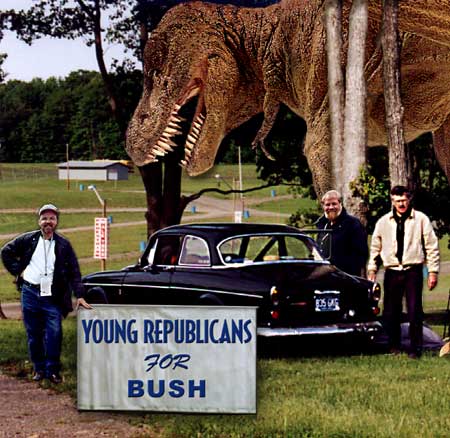
The Race
Sunday morning found all the race cars massed for a photo shoot in a light rain. The weather had been unpredictable all weekend, keeping the racers guessing about which tires to mount for each practice session (those that could afford to bring more than one set, anyway). Rain might also affect the outcome of the all-Volvo race. It can take away much of the power advantage from the more developed cars, and some drivers are better on wet pavement than others.
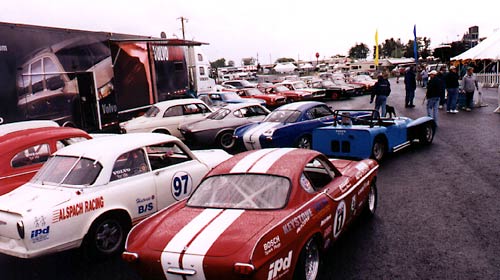
Around noon, our whole crew got together and went looking for Press Hospitality once again. It was Mark who, in being rudely ushered out of some place he'd ventured into, was directed to the correct door. There was nothing to distinguish that door from any other -- I guess they figured anyone with press credentials would be enough of a snoop to do exactly what Mark had done and that's how it was supposed to work.
Behind that mystery door was a large room with picture windows fronting right on the Start/Finish line, lots of devices with wires coming out the back, racks of paper with the latest statistics on every racer, a variety of guys looking just like reporters do in the movies, and -- last but not least -- a bunch of stuff that very much resembled decent food and drink. We ate while watching Porsches zoom by the windows and sorting out who would go where to get good pictures of the race we had all come to see, which was starting in (hey, we better go right now!) 15 minutes.
I headed down to The Boot again. There's a great spot there where you can see cars come down a hill right at you before turning left onto a short straight behind some trees. They reappear just before going into a sharp 180-degree right (The Toe, I suppose) and exiting onto an uphill straight, then around another right and out of sight. You get a preview of the order before they go behind the trees and can plan what to shoot by the time they come close enough to make a good picture (our camera doesn't have much of a lens, I'm afraid).
The track had dried out completely by the time two pace cars led the Volvos around. Surprisingly, there was a second pace lap -- maybe the officials hadn't liked the lineup the first time around. Then came that chills-down-the-spine sound of revving engines and the race was on.
Duane came down the hill a good second in front of the pack and proceeded to widen the gap on almost every lap except for one in the middle of the race. He may have gotten caught in traffic or something like that. Thereafter, he resumed stretching his lead. If he stayed on pavement and nothing broke, it was clear from the start that he'd win. He did stay on the pavement and nothing broke, so that was a done deal.
John Parker, Patty Enzman-Alspach, Rich Kushner in his 122S and Rob Keller in the ex-Lans Stout 1800E, in that order, put on a very tight race for second place. Rob looked to be just a bit short on enough power to move out of the fifth spot, but he hung right in there. John, Patty and Rich had a real race going.
The next group was Gary Jebsen, Dave Rauch and Dave Winters, all in 1800s. I'd expected Ken Rodenbush to be somewhere in that mix, but he came coasting around the 180 and parked his yellow 1800 on the first lap. He'd blown a head gasket in practice the previous afternoon and only had a thinner replacement to put in. "Yep, it's a hand grenade," he'd told me. It was.
Richard Gordon did very well in Ken's older 1800 (the red one usually driven by Ken's son Josh) until clutch and shifter problems late in the race slowed him down, giving Jim Stem's 140 an unopposed shot at that spot. It was great to see Richard racing again after years of hiatus. He was really jazzed to be doing it again (wife Judy expressed a different opinion on the matter) and I hope he continues.
John Hamilton's lone PV was subjected to the most egregious blocking I've ever seen in vintage racing. In most associations, it's considered proper to make one move on a straight when in front of another car -- you can position yourself for the next turn however you like. Under some rules, three moves are legal. Under no circumstances, however, may one simply weave from side to side across the width of the track to prevent a faster car from passing, and that's exactly what an individual (I won't publish his name) was doing to John. He looked like he was warming up his tires on the first lap of a practice session, except this was the middle of a race. He did this repeatedly, in full view of spectators and stewards alike.
Such conduct would get a driver black flagged, and possibly suspended, in most associations. In this race, however, there were essentially no rules at all -- it was a special feature, run under no particular rules, and anything goes.
Of all the cars that actually finished the race, Rick Hayden trailed the pack. The newly-restored red Riley car had developed teething pains earlier and Rick ran the race in the black backup car. It was almost painfully slow, and I figured he'd simply brought it along for show and hadn't prepped it to race at all. This turned out to be correct -- he was running it with no oil cooler and on skinny street tires. I give Rick full points for getting out there anyway, just to give Art Riley, who was attending as Grand Marshall of the event, the chance to see one of his old cars race again. Rick did a great job keeping out of the way of traffic, waving everyone else by and generally entertaining the corner workers with low-traction sliding around.
A fair number of cars did not finish. Parker, Alspach, Kushner and Keller had been racing very close to one another all along. On lap eight, this suddenly changed to Parker with a clear lead over Kushner and the other two nowhere in sight. I dreaded the thought that one of them had actually run into another, perhaps resulting in a wreck. In fact, there had been two separate incidents. Patty's car broke a lower ball joint going into turn one and had spun into the fence. She was shaken up but okay; her car had some damage but looked like it could be repaired. I don't know if Rich Kushner's racing suit needed a cleaning after that or not, but it must have been exciting for him as well.
Some major part of Rob Keller's motor had exited the block, leaving a hole one could put one's fist through. Rob and Randy had pieced it together out of the best parts of two other motors that had blown up, so I'd say they did pretty well with it to get that far, considering.
Since that day, I've heard some talk (not anyone who actually raced in the event) that the race didn't "prove" anything. I'm not sure in the first place that any single race proves anything much beyond the fact that one driver wins it. Certainly this particular race was amongst cars that wouldn't usually compete against one another and were not built to do so. I don't have any idea who the "best" driver is and I don't know what the finishing order would have been if the weather or the rules had been different. I do know that on this particular Sunday afternoon, in this particular race, against these particular other cars, at Watkins Glen in New York State, Duane Matejka completed 12 laps in less time than anyone else and crossed the finish line first.
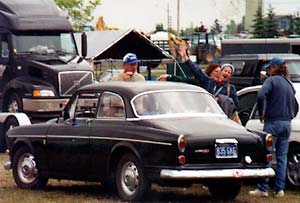 Time to Go Time to Go
We had more stops to make before our trip would be over and had to get rolling soon after the race. Neither Marsha nor I wanted to leave. We rarely have the chance to see Mark, Deb, Brooks, Lee and Michael in person, and never all at once. If Cameron and David [Hueppchen] could have come, it would have been that much better yet. I really enjoyed seeing Dave and Carron Rauch again, spending some more time with John Parker, and meeting Duane, John Hamilton and a bunch of other fine folks.
We really must do this more often. Sick or not, I wouldn't have missed it for the world.
The three race car photos are by Brooks Townes
Watkins Glen Photo Gallery
Easy-print version of this article
|
